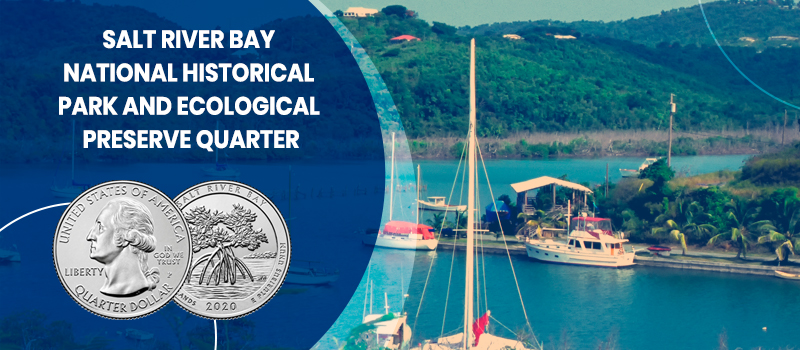Salt River Bay National Historical Park and Ecological Preserve Quarter

The Salt Bay National Historical Park and Ecological Preserve is situated on the island of St. Croix in the U.S. Virgin Islands. The Park was established in 1992 by the National Park service and the Government of the Virgin Islands of the United States. This year the 53rd America the Beautiful quarter honors this piece of heaven tucked away in the Caribbean.
The Salt River Bay is famous for two things: Columbus landing at St. Croix and the Bio-luminescent bay around the Mangrove forests.
Columbus landing at St. Croix
St. Croix preserves the 'Columbus landing site' marked by Fort Sale which is said to be where the Columbus expedition members landed on United States territory. This was during the 2nd voyage of Columbus when at the height of his popularity with the Spanish royals, a second trip was sponsored after the successful first one.
For the 2nd voyage, Chris Columbus came with 15 ships; two big ones called the Marigalante and the Gallega; and 13 smaller ones called the Fraila, San Juan, Colina, Gallarda, Gutierre, Bonial, Rodriga, Triana, Vieja, Prieta, Gorda, Cardera, and Quintera. He landed in St. Croix on November 14th 1493 which he named Santa Cruz. This is the only place in the United States that Columbus ever set his foot on. It was also the first time the Old World and New World locked horns with each other, as the Spaniards had an altercation with the Caribs they encountered. That first battle site was named Cabo de la Flecha (Cape of the Arrow) by Columbus himself as seen in his ship logs.
Within the next 100 years, due to European diseases and firepower, the island of Santa Cruz or St. Croix as it would be known later became completely uninhabited. The ensuing centuries saw different European flags fly in St. Croix - English, French, Dutch and finally the Danish. They were called the Danish West Indies in the 17th and 18th century and then the independent Kingdom of Denmark in 19th century. In 1917, the Danish sold the islands to United States of America through the Treaty of the Danish West Indies for a sum of US$25,000,000 in gold!
Salt Bay Ecological Preserve
The Ecological Preserve protects a bioluminescent bay, mangrove forests, estuarine and marine environments. A micro-organism, the dinoflagellate Pyrodinium bahamense causes the bay to glow. These micro-organisms are related to red mangrove trees that are abundant in the Salt Bay at St. Croix. Every year thousands of people flock to see the luminescent effect in the night.
The 53rd America the Beautiful quarter design
The 53rd ATB quarter honoring this National Historical park and Ecological preserve has a reverse design that shows a red mangrove tree in an early stage of its life cycle as it evolves from a very small plant to an adult tree. While the design honors the quarter, it also brings to notice the endangered red mangrove trees that are critical to sustain the ecosystems in places like the Virgin Islands.
This entry was posted in General, U.S. Coins on June 18, 2020 by lavanya kannan

Leave a comment